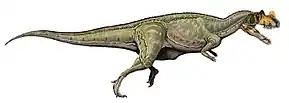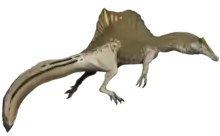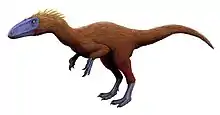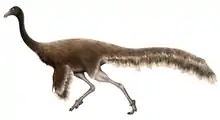Aviatyrannis
Aviatyrannis is a genus of carnivorous tyrannosauroid theropod dinosaur from the Kimmeridgian stage of the Late Jurassic found in Portugal.
| Aviatyrannis | |
|---|---|
 | |
| Diagram of fossils assigned to Aviatyrannis | |
| Scientific classification | |
| Kingdom: | Animalia |
| Phylum: | Chordata |
| Clade: | Dinosauria |
| Clade: | Saurischia |
| Clade: | Theropoda |
| Clade: | Tyrannoraptora |
| Superfamily: | †Tyrannosauroidea |
| Clade: | †Pantyrannosauria |
| Genus: | †Aviatyrannis Rauhut, 2003 |
| Species: | †A. jurassica |
| Binomial name | |
| †Aviatyrannis jurassica Rauhut, 2003 | |
Discovery and naming
In 2000 Oliver Walter Mischa Rauhut reported the find of tyrannosauroid material in the lignite coal mine of Guimarota near Leiria, which he referred to Stokesosaurus.[1] Later concluding the distinctiveness of the material justified a separate genus, Rauhut in 2003 named and described it as the type species Aviatyrannis jurassica.[2] The species name was by Rauhut given the intended meaning of "tyrant's grandmother from the Jurassic".[2] The generic name is derived from Latin avia, "grandmother", and tyrannus, "tyrant", on the presumption tyrannis would be its genitive.[2] The specific name means "Jurassic".[2]
The holotype, IPFUB Gui Th 1, was found in a layer of the Alcobaça Formation dating from the early Kimmeridgian, about 155 million years old. It consists of a right ilium. Rauhut in 2003 referred two other bones to Aviatyrannis: IPFUB Gui Th 2, a partial right ilium, and IPFUB Gui Th 3, a right ischium. The referred elements represent slightly larger individuals. Additionally sixteen isolated teeth were referred: IPFUB GUI D 89-91: three teeth of the premaxilla, and IPFUB GUI D 174-186: thirteen teeth of the maxilla and dentary.[2] These had in 1998 been described by Jens Zinke.[3] Rauhut also hypothesised that a number of specimens referred to Stokesosaurus might actually belong to Aviatyrannis.[2]
Description
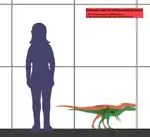
Like other early tyrannosauroids, Aviatyrannis was a rather small bipedal predator. The holotype specimen IPFUB Gui Th 1, for example, is an ilium only ninety millimeters long. It may have belonged to a juvenile.[4] In 2010 Gregory S. Paul estimated its length at one metre, its weight at five kilogrammes.[4] The ilium is elongated and low with the typical tyrannosauroid vertical ridge on the outer blade surface above the hip joint.[2] The teeth of the praemaxilla have a D-shaped cross-section. The maxillary and dentary teeth are elongated, only recurving near the top, with perpendicular denticles on both edges. Their bases are circular in cross-section; the top of the tooth crown is more flattened.[3]
Classification
Aviatyrannis was in 2003 by Rauhut placed in the Tyrannosauroidea, in a basal position.[2] Aviatyrannis is one of the oldest tyrannosauroids ever found, the oldest being Proceratosaurus (or, possibly, Iliosuchus).[2]
See also
References
- Rauhut, O.W.M., 2000, "The dinosaur fauna from the Guimarota mine", pp 75-82 In: Martin and Krebs (eds.). Guimarota - A Jurassic Ecosystem Verlag Dr. Friedrich Pfeil, München
- Oliver W. M. Rauhut. (2003). "A tyrannosauroid dinosaur from the Upper Jurassic of Portugal". Palaeontology. 46 (5): 903–910. doi:10.1111/1475-4983.00325.
- Zinke, J., 1998, "Small theropod teeth from the Upper Jurassic coal mine of Guimarota (Portugal)", Paläontologische Zeitschrift 72(1/2): 179-189
- Paul, G.S., 2010, The Princeton Field Guide to Dinosaurs, Princeton University Press p. 100
